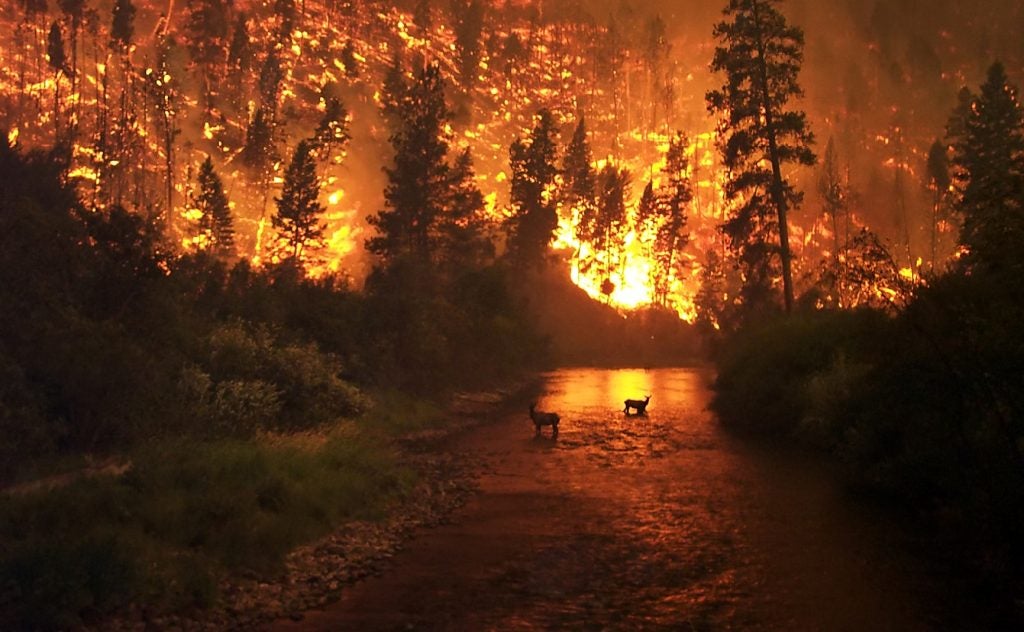Halloween has arrived, and it’s time once again for goblins, gremlins, and ghost stories.
But there’s another threat brewing that’s much more frightening – because it’s real.
An unrecognizable world is quickly creeping up on us as climate change progresses – and the anticipated impacts are enough to rattle anyone’s skeleton.
Here are five of the scariest aspects of climate change. Read on if you dare ….
- Extreme weather is becoming more extreme
A changing climate paves the way for extreme weather events to live up to their name.
In 2017 alone we saw fatal events worldwide, including:
- A heat wave in India
- The most severe drought in Somalian history
- Devastating wildfires in northern California
- An onslaught of record-breaking hurricanes in the Caribbean, U.S., and even Ireland
- Weeks of heavy rainfall and flooding in Nepal, Bangladesh, and India
The fingerprints of climate change can be found on each of these events.
As global temperatures continue to rise, heat waves are expected to become more intense, frequent, and longer lasting.
Scientists also predict that rainfall patterns will continue to shift, increasing regional risk for widespread drought and flooding.
Drought conditions may also prompt wildfires to occur more frequently and within a longer fire season. The wildfire season in the western U.S. is already weeks longer than in previous years.
Hurricanes are also influenced by climate change. Rising sea surface temperatures, a moister atmosphere, and changing atmospheric circulation patterns have the potential to increase hurricanes’ power and travel paths.
Extreme weather intensification impacts human health and development in many ways – extreme heat events directly generate health hazards such as heat stroke, while drought and wildfires threaten crop and ecosystem stability.
The 2017 hurricane season has already demonstrated the shocking consequences of intensified hurricanes and flooding, with Hurricanes Harvey, Irma, and Maria killing more than 150 people and causing as much as $300 billion in damages in the U.S. alone.
- Tipping points loom in near future
A particularly alarming facet of climate change is the threat of irreversible changes to climate conditions, called “tipping elements.”
These components of the climate system earn their title from a possession of critical thresholds, or “tipping points,” beyond which a tiny change can dramatically alter the state of the system.
Many tipping elements have been identified by scientists, and some may have already passed their critical threshold. For example, a vicious cycle of sea ice melt has already been triggered, leading scientists to predict that Arctic summers will be ice-free before mid-century.
Imminent tipping points also exist for melting ice sheets, particularly those of Greenland and West Antarctica, where full ice sheet collapse could result in global sea level rise of up to 20 feet and 16 feet respectively.
Coral reefs too are rapidly approaching a grave tipping point. Essential relationships between algae and corals begin to break down as ocean waters rise in temperature and acidity. Without stabilizing these changes, the majority of global reef systems may collapse before global temperatures reach a two-degree Celsuis warming threshold.
- Coastal communities battle sea level rise
Sea level rise is one of the most visible impacts of climate change, as increased coastal erosion physically erases continental borders.
As the climate warms, ocean waters expand and ice sheets and glaciers melt. Both factors contribute to a rising sea level at an accelerating rate. Communities in Alaska and several Pacific Islands are already fleeing rising seas – relocating as their villages are engulfed and eroded.
Rising sea levels also intensify damages from extreme weather events such as hurricanes. A higher sea level allows storm surges to grow in height and volume, exacerbating flooding and associated damages.
As water levels continue to rise, more coastal communities will feel the consequences. Many major cities are located on coastlines, with almost 40 percent of U.S. citizens living in coastal cities.
Protecting people from this creeping threat will be difficult and costly – as we’ve already seen in the aftermath of coastal storms such as Superstorm Sandy.
- Humans are nearing uncharted climate territory
A globally averaged two-degree Celsius (or 3.6 degrees Fahrenheit) of warming over preindustrial levels is the most widely suggested threshold we need to stay “well” below.
The threshold was first proposed by William Nordhaus in the 1970’s, in part because of its historical significance – the human species has never lived during a time in which global temperatures were equivalent to two-degrees Celsius above preindustrial levels.
The unprecedented nature of this benchmark provided a foundation for alarm that carried the two-degrees Celsius value into political and scientific discussions for decades.
In a changing climate, unprecedented events will become the norm.
In some cases, they already have.
As infectious diseases spread to previously untouched regions and an Arctic ozone hole threatens to open, people are beginning to catch the first glimpses of the new world we are creating – one that is in many ways more hostile and dangerous than the one we leave behind.
- Many American politicians deny the problem
 Perhaps the only thing more terrifying than the impacts of climate change is the overwhelming denial of their existence by some political leaders in the U.S.
Perhaps the only thing more terrifying than the impacts of climate change is the overwhelming denial of their existence by some political leaders in the U.S.
The Paris Agreement served as a major step forward in promoting climate change mitigation policy on an international scale, with almost every nation agreeing to tackle this looming threat.
Then in June, President Trump announced his intent to withdraw from the agreement. That means the United States will be one of only two countries – out of almost 200 – failing to participate in the accords.
The same efforts towards dismantling U.S. climate progress can be seen in recent national policy. Environmental Protection Agency Administrator Scott Pruitt (who recently claimed that carbon dioxide is not a major contributor to global warming) is perhaps the most visible of an exhausting list of leaders within the current Administration who deny climate science. The Administration is trying to undermine or reverse policies addressing climate change, including the Clean Power Plan, and information about climate change is vanishing from official agency websites.
The rest of the globe is striving to implement meaningful climate policy, including China’s unparalleled growth in renewable energy support. Soon the U.S. will be left in the dust in the race for a greener world.
Be afraid. Be very afraid. Then do something about it.
We can’t protect you from the monsters hiding under your bed. But combating the ominous impacts of climate change is a much more hopeful endeavor.
For more information on how you can help, click here.












2 Comments
As climate change leads to dramatic changes in the day to day weather patterns, with hurricanes and floods frequently headlining the news around the world, it makes you wonder why people are still turning a blind eye to this ginormous issue. Is it so difficult for people to take an active role in the preservation of our mother earth?
https://goo.gl/6DrXiG
I am afraid!…of the end of this (already too long) beautiful stretch of warm, life-nurturing climate that has allowed our species to explode in societal complexity; number of individuals and sustained good health with greatly extended life span and general comfort. This little interglacial period of ours (based on earlier ones) is already about 1,000 years overdue to finish (this is simple history, but feel free to deny that). Anywho, here’s what the Danes have to say about the Greenland Ice budget (hint 5th highest gain on record for 2016-17 and this year looking like a repeat. Again, feel free to deny what you see with your own two eyes):
http://www.dmi.dk/en/groenland/maalinger/greenland-ice-sheet-surface-mass-budget/
Ice GAINS in the Arctic:
https://realclimatescience.com/wp-content/uploads/2017/11/2017-11-01023912_shadow-1.png
And NASA on Antarctica:
https://www.nasa.gov/feature/goddard/nasa-study-mass-gains-of-antarctic-ice-sheet-greater-than-losses
And while I’m at it, perhaps you can explain these:
Consensus scientific opinion in 1974:
https://realclimatescience.com/2017/10/wmo-1940-warmth-extraordinary-post-1940-cooling-real/
The CIA’s warning of the threat it posed:
https://realclimatescience.com/wp-content/uploads/2017/05/Image469_shadow.png
The preposterous skullduggery that’s taken place since:
https://realclimatescience.com/wp-content/uploads/2017/10/2017-10-21142108_shadow.png
https://realclimatescience.com/wp-content/uploads/2017/05/PaintImage78.gif
Glaring examples of OUTRIGHT FRAUD:
https://realclimatescience.com/wp-content/uploads/2017/01/Screen-Shot-2017-01-10-at-7.27.04-AM.gif
THE INCOMPETENT MORONS (or liars) who go along with it:
http://blogs.edf.org/climate411/2017/10/30/a-real-halloween-horror-story-the-five-scariest-aspects-of-climate-change/
AND, finally…have been on the side of all of this and after having wagged a sanctimonious finger in others’ faces for almost 2 decades before digging a bit deeper and seeing how badly used I (or at least my faith in politicians and their pseudo science flunkies) have been treated…here’s my current level of tolerance toward UTTER GARBAGE like this and how may of my tax dollars I’ll allow/vote to have allocated to its continuation = ZERO (0).
Hhere’s a point to add to your list of scariness:
LAST POINT: THE Authors of this blog post believe that all of these scary things are your fault (and ours, mother nature has nothing to do with it) AND YOU (but not WE) must limit your energy consumption so much so that you’ll be living next to the Ingalls family…in the 1870s! All the while, our spiritual leader, Nobel Laureate Al Gore consumes more than 21 TIMES that of the average American FAMILY and that’s only at ONE of his properties (in TN). Who knows about his ex (Tipper) who lives at the beach-side estate in SO. CAL. (1 foot above sea level) that was bought for $9 million back in 2009. It also doesn’t consider his carbon footprint as it relates to his fliying schedule…to plug his movie about how YOU (sinner) have to cut way down. Scariest of all on this point: Young kids now read garbage like this post and might actually believe it is their fault, because there doens’t seem to be enough thoughtful and/or courageous parents/adults to help them learn to think for themselves.
Morons.